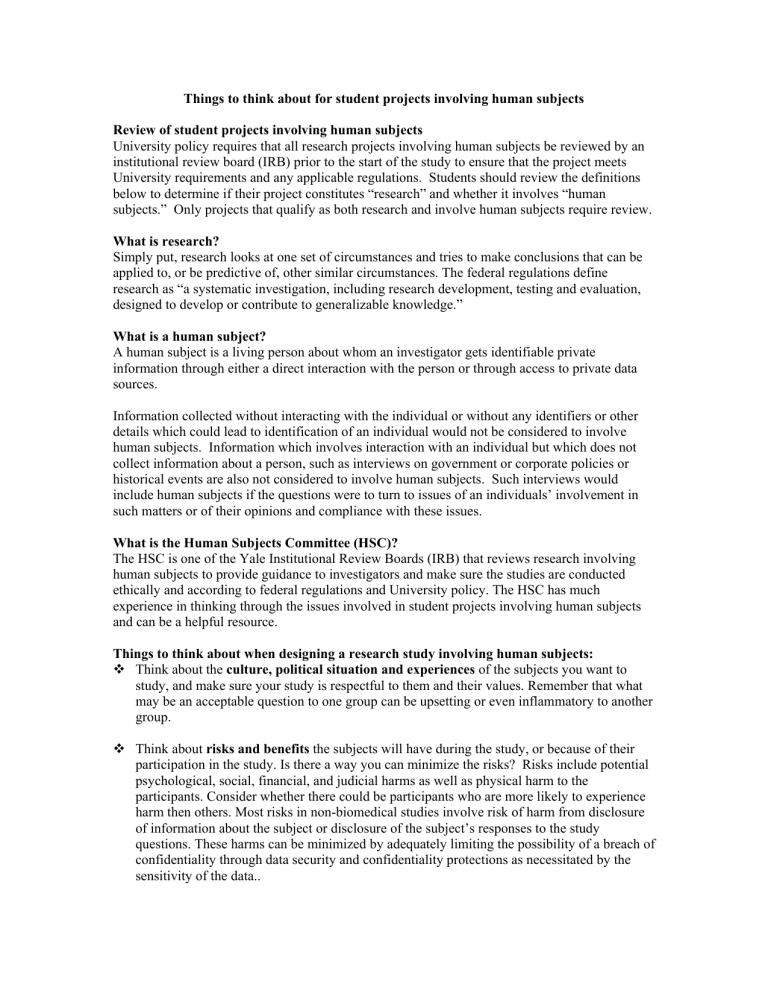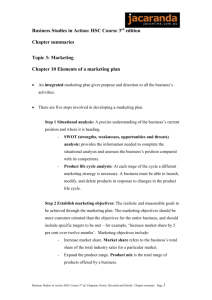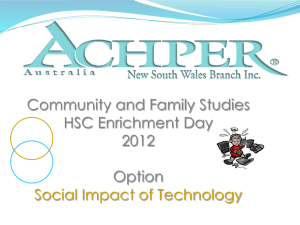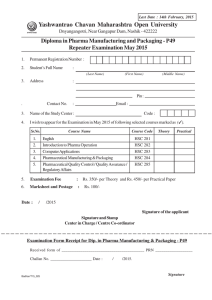Things to think about for student projects involving human subjects

Things to think about for student projects involving human subjects
Review of student projects involving human subjects
University policy requires that all research projects involving human subjects be reviewed by an institutional review board (IRB) prior to the start of the study to ensure that the project meets
University requirements and any applicable regulations. Students should review the definitions below to determine if their project constitutes “research” and whether it involves “human subjects.” Only projects that qualify as both research and involve human subjects require review.
What is research?
Simply put, research looks at one set of circumstances and tries to make conclusions that can be applied to, or be predictive of, other similar circumstances. The federal regulations define research as “a systematic investigation, including research development, testing and evaluation, designed to develop or contribute to generalizable knowledge.”
What is a human subject?
A human subject is a living person about whom an investigator gets identifiable private information through either a direct interaction with the person or through access to private data sources.
Information collected without interacting with the individual or without any identifiers or other details which could lead to identification of an individual would not be considered to involve human subjects. Information which involves interaction with an individual but which does not collect information about a person, such as interviews on government or corporate policies or historical events are also not considered to involve human subjects. Such interviews would include human subjects if the questions were to turn to issues of an individuals’ involvement in such matters or of their opinions and compliance with these issues.
What is the Human Subjects Committee (HSC)?
The HSC is one of the Yale Institutional Review Boards (IRB) that reviews research involving human subjects to provide guidance to investigators and make sure the studies are conducted ethically and according to federal regulations and University policy. The HSC has much experience in thinking through the issues involved in student projects involving human subjects and can be a helpful resource.
Things to think about when designing a research study involving human subjects:
Think about the culture, political situation and experiences of the subjects you want to study, and make sure your study is respectful to them and their values. Remember that what may be an acceptable question to one group can be upsetting or even inflammatory to another group.
Think about risks and benefits the subjects will have during the study, or because of their participation in the study. Is there a way you can minimize the risks? Risks include potential psychological, social, financial, and judicial harms as well as physical harm to the participants. Consider whether there could be participants who are more likely to experience harm then others. Most risks in non-biomedical studies involve risk of harm from disclosure of information about the subject or disclosure of the subject’s responses to the study questions. These harms can be minimized by adequately limiting the possibility of a breach of confidentiality through data security and confidentiality protections as necessitated by the sensitivity of the data..
Think about special, vulnerable populations such as children, economically or educationally disadvantaged, or those who may have a limited ability to make decisions for themselves. If it is necessary that the study include a vulnerable population, special precautions may be needed, such as getting a parent’s or caregiver’s permission to speak with the vulnerable person.
Limit the subject identifiers that will be recorded . If possible, try to design the study so that subject names or other information that could specifically identify a person (such as date of birth) are not recorded. Studies which do not collect any information that could be used to identify the individual are considered anonymous . Note that even without names or other direct identifiers, data wouldn’t be anonymous if the demographics recorded are sufficient to allow identification of the individual participants..
If you need to collect names or other information that could identify an individual person, keep the information confidential . The HSC suggests creating a list that contains a link between the subject’s name and a random code number or pseudonym, and then using only the code number/pseudonym to mark the data and responses from that subject. The list that contains the coded link should be kept secure, and separate from the data and responses. That way, the subject’s data is kept confidential.
In all cases, the investigator should inform subjects about:
• the purpose of the study
• what is involved and how much time it will take
• whether there are any risks or benefits to being in the study
• how their identity or information they provide will be kept confidential
• that being in the study is voluntary and that they can decide they no longer want to be in the study at any time.
Your study will fall into one of the categories below .
As you read the categories, think about which one best fits your study. Note that in some cases a study requiring IRB review may be made exempt from review by not recording the names or other information about subjects which could individually identify them (see item B under the
Exempt category).
1.
Not research.
Student projects that are not designed to be applied to or predictive of similar circumstances are not considered research. Many, but not all, historical projects are not considered to be research as defined under the regulations.
2.
Research not involving human subjects . The study does not use identifiable information about an individual person.
3.
Exempt studies. Exempt studies fall within regulatory defined categories and are determined to be exempt from further review by the HSC. Common studies qualifying for exemption fall into one of the following categories: a.
Studies that compare different educational techniques or methods. b.
Studies that do not involve children, using surveys, educational tests or interviews that do not collect identified information, OR the subject’s responses
won’t put the subject at risk for criminal action or damage to the subject’s social standing, financial standing or reputation. c.
Studies that survey or interview elected or appointed public officials in their role as an elected or appointed official. d.
Studies that use only pre-existing data, records or documents that are publicly available or record data from the pre-existing records completely anonymously.
4.
Research studies likely requiring IRB approval. Studies that do not fall into the above categories will require review and approval prior to the study being started.
WHAT TO DO:
1.
Go to the HSC website and fill out an application: http://www.yale.edu/hsc/Investigator/forms/application_form.doc
2.
Hand in/e-mail the application to the HSC along with any materials you will be giving to subjects such as consent forms or questionnaires.
When in doubt, the HSC can provide assistance in determining if a given project must be reviewed under Yale policy. Send an email to human.subjects@yale.edu
providing a brief description of your project or call 436-3650.






